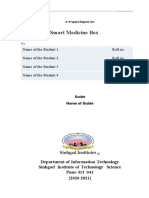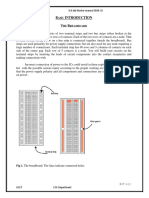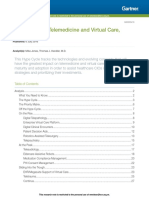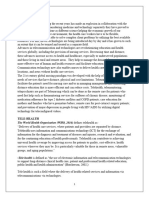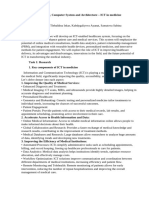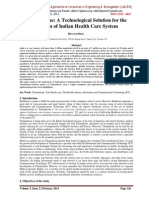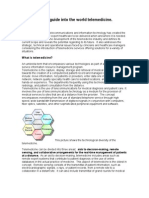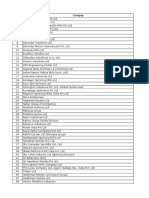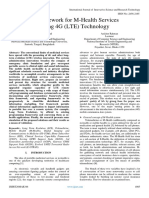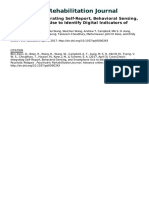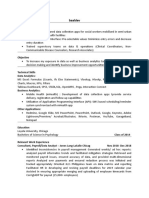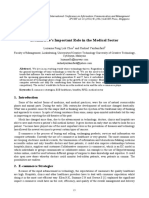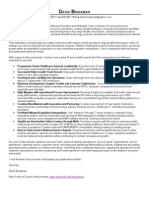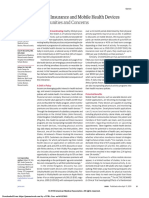Telemedicine: Cellular Operators Association of India
Telemedicine: Cellular Operators Association of India
Uploaded by
hanumanthgowdaCopyright:
Available Formats
Telemedicine: Cellular Operators Association of India
Telemedicine: Cellular Operators Association of India
Uploaded by
hanumanthgowdaOriginal Description:
Original Title
Copyright
Available Formats
Share this document
Did you find this document useful?
Is this content inappropriate?
Copyright:
Available Formats
Telemedicine: Cellular Operators Association of India
Telemedicine: Cellular Operators Association of India
Uploaded by
hanumanthgowdaCopyright:
Available Formats
Cellular Operators Association of India
TELEMEDICINE
July 2011
Cellular Operators Association Of India
2
Contents
EXECUTIVE SUMMARY ............................................................................................................................. 3
INTRODUCTION TO TELEMEDICINE .......................................................................................................... 4
BENEFITS OF TELEMEDICINE .................................................................................................................... 6
TELEMEDICINE WORLD OVER .................................................................................................................. 7
TELEMEDICINE IN INDIA .......................................................................................................................... 9
KEY DRIVERS FOR TELEMEDICINE IN INDIA............................................................................................. 14
CHALLENGES FOR TELEMEDICINE IN INDIA ............................................................................................ 17
MOBILE HEALTH IN TELEMEDICINE ..................................................................................................... 19
FUTURE PERSPECTIVE ............................................................................................................................ 23
CONCLUSION ......................................................................................................................................... 24
Cellular Operators Association Of India
3
EXECUTIVE SUMMARY
India has a vast population, 70% of which lives in villages which often have difficult or
inaccessible terrain. This makes deployment of medical facilities a great challenge. India also
has one of the lowest per capita healthcare spending by the Goverment at USD 32 while
developed countries have a per capita healthcare spending of USD 4,590 by Goverment. The
spending of private sector on health care is about 1.5 times the government spending, but
these healthcare facilities are concentrated in the urban areas.
Given the current scenario, telemedicine becomes a high potential tool to bridge the gaps in
healthcare in India. In 2007 revenue from the Indian tele-medicine market stood at USD 50mn.
According to BCG telecom enabled services market, including tele-medicine, in India would be
USD 200 bn by revenue and it will generate 40 mn new jobs by the year 2020. The opportunity
provided by tele-medicine is too large to ignore.
India already has a few significant m-health initiatives like m-dhil which provides healthcare
information to the general Indian public mainly through text messaging, m-Pedigree has
created a mobile platform to track and check the validity of medicines, e-Healthpoints a
network of modern clinics that offer telemedicine, clean water, diagnostics, and safe drugs and
World Health Partners a multi-level service delivery network which leverages the latest in
telemedicine and point-of-care diagnostic technology.
There needs to be a continuous effort from both government and private players to deploy
tele-medicine and help develop the ecosystem of telecom equipment manufacturers, software
vendors, diagnostic techniques and drug delivery to realize the full potential of tele-medicine.
Cellular Operators Association Of India
4
INTRODUCTION TO TELEMEDICINE
According to World Health Organisation, telemedicine is defined as, The delivery of healthcare
services, where distance is a critical factor, by all healthcare professionals using information and
communication technologies for the exchange of valid information for diagnosis, treatment and
prevention of disease and injuries, research and evaluation, and for continuing education of
healthcare providers, all in the interests of advancing the health of individuals and their
communities.
Telemedicine is not a specialty but a tool which uses Information Communication Technology
(ICT) and clinical medicine. It is a subcategory of a wider Tele-health care category which
includes applications like fall detection, bed monitoring, panic alarm etc. Telemedicine has
enormous potential to meet the challenges of present medical infrastructure mainly capacity
and delivery of healthcare. This is especially relevant in rural and remote locations where the
delivery of health services is a major concern.
Telemedicine is practiced on the basis of two concepts real-time i.e. synchronous and store-
and-forward and home health i.e. asynchronous. Real-time telemedicine requires presence of
both parties at the same time and a communication link between them that allows real-time
interaction and data transfer between the two parties. Store-and-forward methods acquire and
store medical data e.g. medical images, bio signals in a database or storage location and can be
accessed by medical specialist at a convenient time. Simultaneous presence of both parties is
not required.
Cellular Operators Association Of India
5
Source: A Telemedicine Platform: A Case Study of Apollo Hospitals Telemedicine Project
Typical Tele-Medicine Network
Telemedicine covers five major health processes:
1. Monitoring: Includes both home bound and mobile health monitoring. Devices remotely
collect and send data from homebound or remotely located patients to a monitoring
station for interpretation. The data may include patients vital signs, ECG and blood
glucose. Such services can supplement the use of home visiting nurses or patients under
general observation. It could help save both trained human resource time and bed
space, which is extremely valuable.
2. Diagnosis: whereby devices examine a patient and a connected physician residing in
another location virtually examines and treats a patient.
3. Triage: a central point, office or call center staffed mainly by nurses that provides basic
health instructions and information but no diagnosis or consultation. These could act as
traffic control and regulation points like reception areas in a hospital albeit from a
remote location.
4. Consultation: wherein a doctor can advise a patient at home or in a distant location or
two doctors in different countries consulting one another.
5. Procedure: these are real-time medical procedures carried out in real-time. These range
from simple to implement procedures like psychiatry to complex invasive robotic
surgeries.
Cellular Operators Association Of India
6
BENEFITS OF TELEMEDICINE
Telemedicine
Rural Physicians & Clinics
Receive education from the
specialist
Enhanced community confidence
in local healthcare
Patients
Immediate urgent care & easy
ac
Early Diagnosis prior to
escalated medical episode
Cost savings from not having to
travel extensively
Equipment & Infrastructure
provider
70%of India's population
resides in villages, thus scale of
deployments should be large for
complete coverage
Specialists/Hospitals in
urban Regions
Expand patient outreach
Major surgical procedures
resulting from the initial
telemedicine consultation
Promotion of Hospital
Revenue from tuition for
clinician education courses
(CME, CNE, etc.)
Better Utilisation of limited staff
Rural Community
Employment Generated
Physicians
The doctors maintain the
records in an organized form
Statistics generation is online &
immediate for future planning
Disease prevalence &epidemics
will be detected immediately
Cellular Operators Association Of India
7
TELEMEDICINE WORLD OVER
Telemedicine has generated a lot of interest world-wide. Its ability to expand the reach of
medical facilities without physical transportation of patients or medical practitioners, address
capacity, trained resource and distance problem and also save cost has been discussed,
researched and piloted world-wide. Regions like Mexico where the doctor patient ratio is bad
and commuting a problem are enthusiastic advocators for adoption of telemedicine.
Few telemedicine projects have been:
Smartphones for medical diagnosis : Research from the University of Calgary's Faculty of
Medicine shows that doctors can make a stroke diagnosis using an iPhone application with the
same accuracy as a diagnosis at a medical computer workstation. This technology can be
particularly useful in rural medical settings. This allows for real-time access to specialists such as
neurologists, regardless of where the physicians and patients are located. In April 2010, the
application was approved by Health Canada so Canadian doctors can now legally make a
primary diagnosis using the device.
Remote medical diagnosis via 3G network under trial in Egypt: On 21
st
April 2011, Qualcomm
announced that it is working with Egyptian mobile network, Mobinil to test a remote tool to
enable dermatologists to use Mobinil's 3G network to diagnose skin conditions remotely.
Mobile phones to the rescue for pregnant women: Pumwani Maternity Hospital, in the
impoverished Nairobi neighborhood of Eastlands, is the site of a trial project using mobile
phones to help HIV-positive mothers avoid passing the virus on to their children. The project
kicked off in December 2008 and is expected to end in mid-2013.
IBM platform for telemedicine: In Denmark, the costs of universal medical care are shared by
the nation and its municipalities. Aarhus, Denmarks second-largest city has long used visiting
nurses and other professionals to monitor chronically ill persons living at home. In a three-
month pilot program, Aarhus recently replaced these onsite visits with remote care monitoring
enabled by IBMs Personal Care Connect solution (PCC), a standards-based open infrastructure
platform for remote monitoring. PCC consists of a data collection component designed to
capture biomedical information at the point of generation (typically, in the patients home); a
server that normalizes and stores the data collected; and an application programming interface
that presents the normalized data.
PCC is built to be scalable, reliable, financially practical and protective of patients privacy.
Important to this solution is an in-home hub that links medical devices to the PCC server. In its
Cellular Operators Association Of India
8
pilot programs, IBM has typically employed Bluetooth-empowered cell phones to act as these
hubs. IBM has also used Bluetooth to provide communications between the medical devices
and the hub.
Consumer-driven healthcare will gather momentum in 2011 as the public takes more
responsibility for its own health, with technology playing a key role, according to Ovum. In a
new report, Ovum states that devices such as smartphones and tablet computers will help to
drive the commercialization of healthcare next year, by allowing the public to monitor health
and prevent illness.
Cellular Operators Association Of India
9
TELEMEDICINE IN INDIA
India has a huge platform for implementation of telemedicine. All medical institutes, medical
colleges and corporate hospitals in the country can be used as telemedicine hubs.
Source: www.telemedindia.org
In India, telemedicine programs are actively supported by Department of Information
Technology (DIT), Indian Space Research Organization (ISRO), NEC Telemedicine program for
North-Eastern states, Apollo Hospitals, Asia Heart Foundation and State governments.
DIT, which acts as a facilitator with the long-term objective of incorporation and effective
utilization of Information Technology (IT) in all major sectors, has taken the following leads in
Telemedicine:
1. Development of Technology
Cellular Operators Association Of India
10
2. Initiation of pilot schemes-Selected Specialty, e.g. Oncology.
3. Standardization initiative, by recommending guidelines and standards for practice of
telemedicine in India
A telemedicine software system has also been developed by the Centre for Development of
Advanced Computing, C-DAC which supports Tele-Cardiology, Tele-Radiology and Tele-
Pathology etc. It uses ISDN, VSAT, POTS and is used to connect the three premier Medical
Institutes of the country (viz. All India Institute of Medical Sciences (AIIMS), New Delhi, Sanjay
Gandhi Post Graduate Institute of Medical Sciences (SGPGIMS), Lucknow and Post Graduate
Institute of Medical Education and Research (PGIMER), Chandigarh). Now it is being connected
to include Medical centers in Rohtak, Shimla and Cuttack. The telemedicine system has been
installed in the School of Tropical Medicine (STM), Kolkata and two District Hospitals. In West
Bengal, two hospitals where telemedicine centers have been established are the First Coronary
Care Unit inaugurated in Siliguri District Hospital, Siliguri, and West Bengal on 24 June, 2001 and
Bankura Sammilani Hospital, Bankura, West Bengal inaugurated on 21 July, 2001.
In the past three years, ISRO telemedicine network has expanded to connect 45 remote and
rural hospitals and 15 super specialty hospitals. The remote / rural nodes include the offshore
islands of Andaman and Nicobar and Lakshadweep, the mountainous and hilly regions of
Jammu and Kashmir including Kargil and Leh, Medical College hospitals in Orissa and some of
the rural / district hospitals in the mainland states. The Telemedicine project is not for profit.
Project sponsored by Rabindranath Tagore International Institute of Cardiac Sciences (RTIICS)
Calcutta, Narayana.
Cellular Operators Association Of India
11
Source: www.telemedindia.org
ISRO Telemedicine Network
In order to strengthen the academic activities further, India has initiated a new project of Tele-
education in hospitals to share academic programmes and live surgery transmission with other
institutions using videoconferencing equipment and ISDN lines. Sir Ganga Ram Hospital enjoys a
highly privileged reputation for being academically oriented, with the recognition of DNB
(Diploma Of National Board) courses and good academic records of its students. At present,
they have DNB courses for 28 specialties recognized by the National Board of Examination, New
Delhi. Over the years, the standard of these training courses at the hospital serve as a
benchmark and a model for other private institutions.
Cellular Operators Association Of India
12
Public private Partnership to ensure uniform, accessible, affordable & equitable healthcare for
rural masses. Catalysed & supported by Department of Science & Technology, Government of
India New Delhi.
The Apollo group of hospitals was a pioneer in starting a pilot project at a secondary level
hospital in a village called Aragonda 16 km from Chitoor (population 5000, Aragonda project) in
Andhra Pradesh. Starting from simple web cameras and ISDN telephone lines today, the village
hospital has a state-of-the-art videoconferencing system and a VSAT (Very Small Aperture
Terminal) satellite installed by ISRO (Indian Space Research Organisation). Coupled with this
was the Sriharikota Space Center project (130 km from Chennai) which formed an important
launch pad of the Indian Space Research Organization in this regard.
Installed in 2002 by Narayana Hrudayalaya, Bangalore, Karnataka the Asia Heart Foundation
Telemedicine initiative it has achieved a figure of more than 2000 tele-cardiology consultation
through an enterprise based network. Escort heart institute & research center project, installed
in 2002 has been involved in tele-cardiology service.
With the support of ISRO, Shankar Nethralaya at Chennai and Meenakshi Eye mission at
Madurai has launched Mobile Tele-ophthalmology service.
Online Telemedicine Research Institute has been involved in R&D activities in telemedicine
hardware and software and has been successfully executing projects of ISRO and DIT with
turnkey approach.
Cellular Operators Association Of India
13
Sr.
No
Hospital Project Details Commenced
1 All India Institute of Medical Sciences
(AIIMS), New Delhi
Connecting primary health
care units to secondary and
tertiary level hospitals
2005
2 Sanjay Gandhi Post Graduate Institute
of Medical Sciences (SGPGIMS),
Lucknow
Connecting primary health
care units to secondary and
tertiary level hospitals
1998
3 Post Graduate Institute of Medical
Education and Research (PGIMER),
Chandigarh
Connecting primary health
care units to secondary and
tertiary level hospitals
2005
4 Medical centers in Rohtak, Shimla and
Cuttack
Connecting primary health
care units to secondary and
tertiary level hospitals
2010
5 School of Tropical Medicine (STM),
Kolkata
Connecting primary health
care units to secondary and
tertiary level hospitals
2002
6 Coronary Care Unit, District Hospital,
Siliguri, and West Bengal
Tele-cardiology 2001
7 Rabindranath Tagore International
Institute of Cardiac Sciences (RTIICS)
Calcutta, Narayana.
Tele-cardiology 2000
8 Apollo Group of Hospitals Tele-cardiology 2001
9 Asia Heart Foundation Tele-cardiology 2002
10 Shankar Nethralaya, Chennai Tele-ophthalmology service 2001
11 Meenakshi Eye Mission, Madurai Tele-ophthalmology service 2009
Cellular Operators Association Of India
14
Hospital Information And Management System (HIMS) In India
Majority of the hospitals in the country are rooted in manual processes, which are difficult to
access. The insurance sector demands for more efficient information storage and retrieval.
Automation alone can help hospitals to meet these challenges. Many sturdy, standard HIMS
solutions have been developed by the major IT companies e.g. Centre for Development of
Advanced Computing (CDAC), Wipro GE Healthcare, Tata Consultancy Services (TCS) and
Siemens Information Systems Ltd (SISL) etc. Currently most of the corporate and some
government hospitals are deploying HIMS. CDAC, an autonomous government IT organization
developed and deployed the first total HIS software in collaboration with SGPGIMS, Lucknow.
Telemedicine solutions were being actively used in India during the Kumbh Mela at Allahabad
and Gujarat quake. There are continuing projects involving SGPGI Lucknow, the IAF station in
Bhuj and AIIMS consultations to the population in Leh.
Many tele-compatible products like ECG. PFT, Uroflow meter, Dicom compatible X-Ray machine
etc. are available for use in conjunction for a telemedicine center. Video conferencing is also
available so that the direct patient to specialist interaction is enhanced.
Patient record keeping software is available in India. These are not only faster than writing, but
better looking aesthetic reports are generated with records available all the time. If all records
of patient can be kept on the computer, the same quality of health care will be available in all
the corners of our country saving on travel and time off work.
A meeting of minds has taken place. After all, a computer is required for sending the records
and a doctor who keeps his records on a computer just needs to send the same record for a
consultation as and- when required for a specialist's opinion.
Cellular Operators Association Of India
15
KEY DRIVERS FOR TELEMEDICINE IN INDIA
India is a vast country with an area of 3.28 mn km sq. and population of more than 1210 mn.
We face capacity, trained medical resource and last mile coverage problems. According to
estimates by the Planning Commission, India is short of 6 lakh doctors and 10 lakh nurses. This
has led to a doctor to patient ratio of about one is to ten thousand. Such low ratios also do not
make medical care affordable. The shortage is more pronounced in our rural communities as
the majority of the doctors live and practice in cities. This when considered in the light of the
fact that India has more than 6.38 lakh villages becomes a problem of greater proportions. The
population to bed ratio in India is one bed per 1,000 people while the WHO average is one bed
per 300.
Shortage of Nurses Shortage of Doctors Population to bed
ratio India
Population to bed
ratio-WHO
10 lakh 6 lakh 10000:1 300:1
Source: http://presidentofindia.nic.in/sp010309.html
To combat these problems various state governments have come up with local solutions. To
tide over acute dearth of doctors in remote areas, Andhra Pradesh launched a mobile health
programme. Vans equipped with basic medical tools and skilled paramedics visit rural parts of
the state to provide instant relief to patients. Karnataka has rolled out 104 ambulance services
which are mobile health units catering to 90 far flung places in the state. But these efforts are
isolated and far in between.
Presently the health delivery system in India is divided into three levels primary, secondary and
tertiary.
Level Public Private
Primary PHCs* and its sub-centers Private Practitioners
Secondary District hospitals Small private hospitals and
nursing homes
Tertiary Teaching hospitals
Nursing homes and Corporate
hospitals
*PHC primary health care
Telemedicine can be used as a solution to bridge the gaps prevailing between the primary and
Cellular Operators Association Of India
16
tertiary level health care system within country and across the continents. Realizing the
potential of telemedicine and to serve the motto of health for all, Government of India is
planning many telemedicine networks in which the primary and secondary level hospitals will
be connected to a tertiary level hospital. SGPGIMS, Lucknow, a tertiary level medical institution
is connected to 3 secondary level medical colleges in Orissa state and 2 primary level district
hospitals in Uttarakhand and one in Uttar Pradesh under different projects sponsored by
various government agencies and state governments.
Telemedicine is a solution that addresses all three problems i.e. capacity, shortage of trained
medical resources and distance problems.
Cellular Operators Association Of India
17
CHALLENGES FOR TELEMEDICINE IN INDIA
Some factors that might inhibit the growth of telemedicine if not addressed properly are:
1. Policy and Financial Factors:
a. Reimbursements: Presently most insurance policies reimburse for medical
treatment subject to admission in hospital. Insurance policy and regulations will
need to be amended for patients availing benefits of telemedicine.
b. Service Payments: How professionals get paid for services rendered needs to be
resolved for telemedicine to become a popular tool.
c. Financial Justification: Before vendors and infrastructure providers invest in the
project policy framework needs to be defined to incentivize the deployment of
telemedicine equipment.
2. Legal Issues:
India does not have any legal guidelines defined in telemedicine which could
lead to legal issues.
3. Clinical Resistance:
a. Implementation of telemedicine is a process change and will require change in
organization culture and structure. Resistance from medical staff for the
adoption of new processes could impede the adoption of telemedicine.
b. Training would be required for medical and support staff.
4. Infrastructure Issues:
a. Although information technology has reached in all corner of the country but the
accessibility to people living in remote and rural area to the nearest health
center (PHCs, CHCs or district hospital) may not be easy due to poor
infrastructure of road and transport.
b. Deployment of telemedicine services infrastructure like regional network with
high speed, electronic patient record system and system for electronic
prescriptions need to be deployed.
c. Interruption in power supply may limit the benefits of telemedicine.
5. Ethical Issues:
Use of telemedicine would use technology for health information exchange
(HIE), computerized patient record (CPR) and electronic medical record (EMR).
These records are stored in databases and need to be maintained by a third
party entity. Medical records are highly confidential information and need to be
protected.
Cellular Operators Association Of India
18
6. Technology Readiness:
Till now India has not seen any large scale deployment of telemedicine. Pilot
projects have been isolated and small scale. Technology readiness for large scale
implementation of telemedicine has not been tested.
Some healthcare professionals have doubt about the quality of images
transmitted for tele-consultation and tele-diagnosis. In tele-radiology,
telepathology, tele-dermatology the quality of image (colour, resolution, field of
view, etc) should be international standards to avoid any wrong interpretation
and mis-diagnosis. The delay in transmission of data may be of critical
importance in tele-mentoring and robotic surgery and have to be reduced to the
minimum.
Cellular Operators Association Of India
19
MOBILE HEALTH IN TELEMEDICINE
M-health leverages mobile devices and information communication technology (ICT) to deliver
health services and information exchange which can increase access, affordability, and quality
of healthcare significantly.
The number of global mobile phone subscribers in 2007 was estimated at 3.1 billion of an
estimated global population of 6.6 billion (47%). These figures are expected to grow to 4.5
billion by 2012, or a 64.7% mobile penetration rate. The greatest growth is expected in Asia,
the Middle East, and Africa. In many countries, the number of mobile phone subscribers has by-
passed the number of fixed-line telephones, this is particularly true in developing countries.
In India, mobile penetration rates have increased markedly, by far the greatest growth rates
are found in urban areas. India's mobile subscriber base rose to 787.28 million at the end of
December 2010, up from 723.28 million in September 2010, according to the latest figures from
the Telecom Regulatory Authority of India (TRAI), which revealed that mobile penetration
reached 63.22%. So, mobile phones may have the potential to provide greater healthcare
access to a larger portion of a population than currently accessible.
One of the first major m-Health initiatives was taken by Apollo Hospitals, using telemedicine to
make secondary and tertiary medical expertise available to rural and peri-urban India through
an audiovisual enabled delivery system. Qualified doctors are scarce in these areas and
telemedicine has filled an important demand supply gap. From the year 2000 to 2009, over
57,000 tele-consultations were performed across various disciplines, from sexual health to
neurology. Apollo is now offering 24/7 consultations for just INR 45, the equivalent of $1, and
has 71 telemedicine centers across India. Due to the success of the program, the Delhi
government is looking to expand the program in the near future in a public private partnership.
Some of the significant m-health initiatives in India are:
1. m-dhil This Bangalore start-up provides healthcare information to the general Indian
public mainly through text messaging, but increasingly through mobile web and digital
content. With a paid subscriber list of over 250,000 users, m-Dhil is becoming somewhat
of a WebMD for the Indian market.
2. m-Pedigree Started in Ghana and now also operating in India, m-Pedigree has created
a mobile platform to track and check the validity of medicines in order to combat the
rampant practice of drug counterfeiting.
3. e-Healthpoints Operating currently in Punjab, e-Healthpoints is creating a network of
modern clinics that offer telemedicine, clean water, diagnostics, and safe drugs to peri-
Cellular Operators Association Of India
20
urban Indians. They recently partnered with Proctor & Gamble to scale 2000 e-
Healthpoints across five north Indian states.
4. World Health Partners This non-profit has created a multi-level service delivery
network which leverages the latest in telemedicine and point-of-care diagnostic
technology to improve access and quality of care to rural and peri-urban India. They are
scaling from Uttar Pradesh to Bihar through funding from the Gates Foundation.
5. NETRA Still in the research lab at MITs Media Lab, NETRA (Near-Eye Tool for
Refractive Assessment) combines an external eye piece with software loaded on a smart
phone to measure refractive conditions (i.e. near/far sightedness and astigmatism) on
site at an extremely reduced cost. Optometrists in the US pay up $8000 for a similar
device, and which is always located in optometrists office. This technology could be a
game changer for rural India.
Along with the growth of m-Health entrepreneurship in India, groups like the m-Health Alliance,
which is a partnership between the Rockefeller Foundation, United Nations Foundation,
Vodafone Foundation, GSM Association, and PEPFAR, plan to spread the m-Health gospel by
setting up an India branch, as well as lead specific projects related to maternal health that
already in the planning stage. Health 2.0, which organises conferences around the latest IT-
enabled health solutions in the US, has plans to come to India in to start fanning the Indian m-
Health flame. M-health India is gaining momentum.
Efforts are ongoing to explore how a broad range of technologies, and most recently m-Health
technologies, can improve such health outcomes as well as generate cost savings within the
health systems of low- and middle-income countries. In some ways, the potential of m-Health
lies in its ability to offer opportunities for direct voice communication (of particular value in
areas of poor literacy rates and limited local language-enable phones) and information transfer
capabilities that previous technologies did not have.
Mobile network operators in India have already taken initiatives towards providing tele-
medicine services. Vodafone has tied up with Blackberry towards a BlackBerry-Vodafone
Telemedicine Services initiative at Nanavati hospital in Mumbai. The service enables users to
access ECG reports directly on their handsets.
Airtel has developed a mHealth umbrella of services, one of the services is
MobiHealthNews a SMS-based health "packs", the content for which is developed by mdhil
and Indiagames.
Uninor has launched a health information dissipation application 'Wellness World' to provides
information on health and welness related issues.
Cellular Operators Association Of India
21
Aircel, in association with the Apollo Hospitals Group has introduced the Aircel Apollo Mobile
HealthCare facility offering telemedicine and Tele Triage services to customers. Under the
telemedicine service, patient data is collected through various processes and is stored and
shared between healthcare professionals to diagnose, treat and follow-up. Tele Triage is a
solution to manage patients health concerns and symptoms via a telephone-based interaction
by doctors. This service provides structured medical advice and a disposition based on the
symptoms. The service is available around the clock from qualified Apollo Clinicians.
Overall, mobile communication technologies are tools that can be leveraged to support
existing workflows within the health sector and between the health sector and the general
public.
Cellular Operators Association Of India
22
COMMENTS
Telemedicine has been trumpeted as the great health care hope for rural India, a technology
that can transform the health status of remote India and medical practice in the country. The
unanswered question is: has it been able to achieve this yet; if not, can it?
Telemedicine in India can be a health innovator and affect real change in the medical scenario
of our country if done well, using multiple hospitals and centers in the country, and on a large
scale.
In order to do this, the Government, via ISRO connectivity, should connect up all district and
village level hospitals to the closest tertiary care centers. The private sector can be used
effectively and every private hospital can be connected to one remote site thus distributing the
load of patients, rather than a handful of hospitals linking up to all the remote sites.
Technologies for telemedicine designed by innovative majors (such as Cisco technologies)
should be low cost, easy to install and use and should be able to work on low cost bandwidths.
Public interest campaigns to increase awareness of the benefits of telemedicine would help. A
standardized training program for all telemedicine providers and users would be helpful in
ensuring the link ups occur rapidly and the centers stay connected without the network going
down.
A viable model wherein a small cost is paid for the telemedicine consultation would make this a
long term successful model of health care delivery. An appointment system that allows patients
to book their doctor visit rather than have to wait for a doctor would help improve usage of
the system. Also a pusher is needed in every telemedicine center to ensure that after the link
up is done; the telemedicine link is actually used on a daily and sustained basis. And finally, data
collection on daily utilization, diagnosis made and treatment plans changed would help to
measure success and impact and provide direction for the future.
Cellular Operators Association Of India
23
FUTURE PERSPECTIVE
India, with its diverse landmass and huge population, is an ideal setting for telemedicine.
Telemedicine activities were started in 1999. The Indian Space Research Organization has been
deploying a SATCOM-based telemedicine network across the country since that year. Various
government agenciesDepartment of Information Technology and Ministry of Health & Family
Welfare, state governments, premier medical and technical institutions of Indiahave taken
initiatives with the aim to provide quality healthcare facilities to the rural and remote parts of
the country. The Government of India has planned and implemented various national-level
projects and also extended telemedicine services to South Asian and African countries. Efforts
are taking place in the field of medical e-learning by establishing digital medical libraries. Some
institutions that are actively involved in telemedicine activities have started curriculum and
non-curriculum telemedicine training programs. To support telemedicine activities within the
country, the Department of Information Technology has defined the Standards for
Telemedicine Systems and the Ministry of Health & Family Welfare has constituted the National
Telemedicine Task Force. There are various government and private telemedicine solution
providers and a few societies and associations actively engaged to create awareness about
telemedicine within the country. With its large medical and IT manpower and expertise in these
areas, India holds great promise and can emerge as a leader in the field of telemedicine.
Cellular Operators Association Of India
24
CONCLUSION
Widespread adoption and diffusion of telemedicine in India remains a mission that is yet to be
accomplished. So far the IT healthcare industry's worth in India is USD 100 million (Rs. 410
crore) (CAGR =18 percent) and IT adoption in healthcare has been pegged at 5 percent (which
is dismally low by any standards). Accordingly, the telemedicine component in this USD 100
million (Rs. 410 crore) IT healthcare industry is nominal (because healthcare IT also includes
computerization of hospitals).
While, we do not claim that telemedicine will solve all (or even most) of India's healthcare
problems, we believe that it is a starting point to offer important contributions to combating
such problems using IT and related technologies. There is unarguably much more to be done for
India to enjoy higher capabilities that telemedicine can offer, such as remote surgeries (tele-
surgery). We believe that as India continues to develop its telemedicine infrastructure,
especially with continued government support through subsidies to private telemedicine
initiatives, its upward trend in healthcare will continue. And we are confident that this will post
India on the path better the quality of life for all Indians across spectrum of socio-economic
strata and irrespective of their life-cycle stage.
You might also like
- BMP5001 Business Management & Career Development (Document30 pagesBMP5001 Business Management & Career Development (cindefuckinbella100% (1)
- Mobile Health and Nutrition Team Implementation Protocol: 2022 GC, 2014 ECDocument41 pagesMobile Health and Nutrition Team Implementation Protocol: 2022 GC, 2014 ECToni Tesfay71% (7)
- Dealer Distributor AgreementDocument9 pagesDealer Distributor Agreementhanumanthgowda100% (1)
- Smart Pill DispenserDocument15 pagesSmart Pill DispenserDeeq HuseenNo ratings yet
- Smart Medication DispenserDocument5 pagesSmart Medication DispenserRegine OmboyNo ratings yet
- Smart Medicine BoxDocument15 pagesSmart Medicine BoxSakshi GosaviNo ratings yet
- Some Ideas For The ProjectDocument44 pagesSome Ideas For The ProjectnizamfairoozNo ratings yet
- Learner Guide Troubleshooting HP Networks 1041 No WatermarkDocument108 pagesLearner Guide Troubleshooting HP Networks 1041 No WatermarkИбрагим Озден ДуманNo ratings yet
- Knex Gears TguideDocument42 pagesKnex Gears TguideJessica ZarateNo ratings yet
- Create Passive Income FTFPDocument12 pagesCreate Passive Income FTFPAdawiyah AliNo ratings yet
- Olive Oil World Market Dynamics and Policy ReformsDocument15 pagesOlive Oil World Market Dynamics and Policy ReformslortizudecNo ratings yet
- IoT BASED PATIENT HEALTH MONITORING SYSTEM PDFDocument13 pagesIoT BASED PATIENT HEALTH MONITORING SYSTEM PDFAman SharmaNo ratings yet
- Magnetic Toy ProjectDocument5 pagesMagnetic Toy ProjectLochearnSchoolNo ratings yet
- Snapcircuits InstructionsDocument124 pagesSnapcircuits InstructionsMak MarsafyNo ratings yet
- Ai For Speech RecognitionDocument24 pagesAi For Speech Recognitionshaikshaa007100% (4)
- New Product Market AnalysisDocument12 pagesNew Product Market AnalysisJarin Tasnim fizaNo ratings yet
- AI For Medicine SpecializationDocument1 pageAI For Medicine SpecializationAbderrazek ZeraiiNo ratings yet
- AI For USADocument19 pagesAI For USAradhey mohapatraNo ratings yet
- ICA Lab Manual PDFDocument193 pagesICA Lab Manual PDFVijay MNo ratings yet
- Snap Circuits Instruction ManualDocument80 pagesSnap Circuits Instruction ManualanandcallsNo ratings yet
- Video LinkDocument155 pagesVideo Linkkushalkolambe22No ratings yet
- Pahal Healthcare Innovation Report Print Ready 14th MayDocument40 pagesPahal Healthcare Innovation Report Print Ready 14th MayAmar SharmaNo ratings yet
- The AI For Manufacturing MarketingDocument15 pagesThe AI For Manufacturing MarketingAndré ReisNo ratings yet
- Smart Pill Box Health Care SystemDocument10 pagesSmart Pill Box Health Care SystemVkNo ratings yet
- Health Monitoring Using Wireless Sensors and GSM - 2014-2015Document46 pagesHealth Monitoring Using Wireless Sensors and GSM - 2014-2015manishaNo ratings yet
- Smart Medicine Pill Box Reminder With Voice and Display For EmergencyDocument4 pagesSmart Medicine Pill Box Reminder With Voice and Display For EmergencyLiew Soon HaoNo ratings yet
- Analog Electronics Msbte ManualDocument207 pagesAnalog Electronics Msbte Manualmatetisantosh37No ratings yet
- Begin Robotics - TimelineDocument17 pagesBegin Robotics - TimelineKritika S NarayanNo ratings yet
- Industry 4.0: Industrial Revolutions and Future ViewDocument5 pagesIndustry 4.0: Industrial Revolutions and Future ViewCharith LiyanageNo ratings yet
- Zendrop Trending ProductsDocument13 pagesZendrop Trending ProductsRoberto Carlos Del ValleNo ratings yet
- Checklist For Systematic Reviews and Research SynthesesDocument7 pagesChecklist For Systematic Reviews and Research SynthesesSyahrul RamadhanNo ratings yet
- Canvas Student GuideDocument419 pagesCanvas Student GuideKeri Gobin SamarooNo ratings yet
- Case Study of The Marubay Rural Renewable Energy TechnologyDocument30 pagesCase Study of The Marubay Rural Renewable Energy TechnologyCollen Sita100% (1)
- Mhealth Report - Final - 19 Nov 12Document54 pagesMhealth Report - Final - 19 Nov 12Euglena VerdeNo ratings yet
- Home Automation Using Google Assistant Ijariie8241 PDFDocument8 pagesHome Automation Using Google Assistant Ijariie8241 PDFTasmiya AnjumNo ratings yet
- (Final) E Book Digital Product BusinessDocument49 pages(Final) E Book Digital Product BusinessmisbahNo ratings yet
- Hype Cycle For Telemedicine and Virtual Care, 2016: Published: 6 July 2016Document52 pagesHype Cycle For Telemedicine and Virtual Care, 2016: Published: 6 July 2016cloudetdelgadoNo ratings yet
- Africa Energy Review 2021Document37 pagesAfrica Energy Review 2021Jedson SilvaNo ratings yet
- TelemedicineDocument8 pagesTelemedicineBarnita Sharma100% (1)
- Definitions and Concepts: TelemedicineDocument6 pagesDefinitions and Concepts: Telemedicinemariet abrahamNo ratings yet
- Research ProposalDocument15 pagesResearch ProposalMartha100% (1)
- New Telemedicine-1Document9 pagesNew Telemedicine-1Martha0% (1)
- TELENURSING00Document28 pagesTELENURSING00Angelina TraiteNo ratings yet
- Assignment 1Document9 pagesAssignment 1qasholiqNo ratings yet
- International Journal of Engineering Research and Development (IJERD)Document3 pagesInternational Journal of Engineering Research and Development (IJERD)IJERDNo ratings yet
- CT080 3 M SPSD 2Document21 pagesCT080 3 M SPSD 2Dipesh GurungNo ratings yet
- Hir 24 387Document7 pagesHir 24 387salad.ass420420No ratings yet
- Telehealth: A Cutting Edge Tool For Healthcare DeliveryDocument4 pagesTelehealth: A Cutting Edge Tool For Healthcare DeliveryIJAR JOURNALNo ratings yet
- TelemedicineDocument20 pagesTelemedicineSwami NathanNo ratings yet
- Tele Medcine PP TDocument48 pagesTele Medcine PP Trajh raj100% (1)
- OMD553-Telehealth Technology: (Open Elective-I)Document15 pagesOMD553-Telehealth Technology: (Open Elective-I)Merlin100% (1)
- Design and Development of Real-Time Patient Monitoring System.Document66 pagesDesign and Development of Real-Time Patient Monitoring System.سيد صادق الشاه حسينNo ratings yet
- The Evolution and Impact of Telemedicine - Bridging Gaps in Healthcare DeliveryDocument3 pagesThe Evolution and Impact of Telemedicine - Bridging Gaps in Healthcare DeliveryrhettallanmcknightNo ratings yet
- A Telemedicine Platform: A Case Study of Apollo Hospitals Telemedicine ProjectDocument25 pagesA Telemedicine Platform: A Case Study of Apollo Hospitals Telemedicine Projecttanushree26No ratings yet
- (IJCST-V9I1P1) :keshav Niranjan, Sonia Yadav, Heera LalDocument3 pages(IJCST-V9I1P1) :keshav Niranjan, Sonia Yadav, Heera LalEighthSenseGroupNo ratings yet
- Institute of Technology, Ulhasnagar. TelemedicineDocument8 pagesInstitute of Technology, Ulhasnagar. TelemedicineLeena LalwaniNo ratings yet
- Get M365Document17 pagesGet M365kiritoblackswordsmen07No ratings yet
- Doctor ProjectDocument66 pagesDoctor Projectسيد صادق الشاه حسينNo ratings yet
- Telemedicine PPT 2Document17 pagesTelemedicine PPT 2Rikky AbdulNo ratings yet
- Tele MedicineDocument10 pagesTele Medicinekathing gatinNo ratings yet
- NTADBM - Group 3 Project ReportDocument16 pagesNTADBM - Group 3 Project ReportntadbmNo ratings yet
- Ijaiem 2014 02 26 054Document6 pagesIjaiem 2014 02 26 054International Journal of Application or Innovation in Engineering & ManagementNo ratings yet
- A Quick Guide Into The World TelemedicineDocument6 pagesA Quick Guide Into The World TelemedicineMahmoud KhaledNo ratings yet
- Kantharaj Kitchen Quote-VinayDocument2 pagesKantharaj Kitchen Quote-VinayhanumanthgowdaNo ratings yet
- Attitudes Towards Designer ClothesDocument142 pagesAttitudes Towards Designer ClotheshanumanthgowdaNo ratings yet
- Brunda's Designers Contract & AgreementDocument3 pagesBrunda's Designers Contract & AgreementhanumanthgowdaNo ratings yet
- Manufactured Detgails Tirupur Expo 08thsept2015Document27 pagesManufactured Detgails Tirupur Expo 08thsept2015hanumanthgowda100% (1)
- PANTONE Fashion Color Report Spring 2016 PDFDocument52 pagesPANTONE Fashion Color Report Spring 2016 PDFJavier NavarroNo ratings yet
- Ecom Plan Reports Sales by Day Sales by Hour Sales Compared To Visitors (Conversions) New Registerd Users New RegiDocument1 pageEcom Plan Reports Sales by Day Sales by Hour Sales Compared To Visitors (Conversions) New Registerd Users New RegihanumanthgowdaNo ratings yet
- Ficci Karnataka: State ProfileDocument2 pagesFicci Karnataka: State ProfilehanumanthgowdaNo ratings yet
- Specialized SME Branches ListDocument21 pagesSpecialized SME Branches ListhanumanthgowdaNo ratings yet
- A Framework For M-Health ServicesDocument11 pagesA Framework For M-Health ServicesInternational Journal of Innovative Science and Research TechnologyNo ratings yet
- Sem LilDocument12 pagesSem Lilmusicdirector16No ratings yet
- HIMSS E-Health SIG White Paper: Access, Efficiency, Effectiveness, and Quality Improve The Health Status of PatientsDocument23 pagesHIMSS E-Health SIG White Paper: Access, Efficiency, Effectiveness, and Quality Improve The Health Status of PatientsSyed NasrullahNo ratings yet
- White Paper Laura HomannDocument14 pagesWhite Paper Laura Homannapi-593340552No ratings yet
- Mobile Health Apps On COVID-19 Launched in The Early DaysDocument17 pagesMobile Health Apps On COVID-19 Launched in The Early Daysharsono harsonoNo ratings yet
- CrossCheck SelfReport Behavioral Sensing Smartphone Identify Digital Indicators Psychotic 2017Document11 pagesCrossCheck SelfReport Behavioral Sensing Smartphone Identify Digital Indicators Psychotic 2017Lucas De Francisco CarvalhoNo ratings yet
- Zafar HasnainDocument3 pagesZafar Hasnainsuhas kohliNo ratings yet
- Awareness and Utilization of Mobile Health Applications Among Teaching and Non Teaching Staff of Nnamdi Azikiwe University Awka, Anambra StateDocument13 pagesAwareness and Utilization of Mobile Health Applications Among Teaching and Non Teaching Staff of Nnamdi Azikiwe University Awka, Anambra StateInternational Journal of Innovative Science and Research TechnologyNo ratings yet
- Internship Project Report On Mobile-Health Applications For The Efficient Delivery of Health Care Facility To People: - A Survey On Woodland RPGDocument42 pagesInternship Project Report On Mobile-Health Applications For The Efficient Delivery of Health Care Facility To People: - A Survey On Woodland RPGBishal RoyNo ratings yet
- Daftar PustakaDocument8 pagesDaftar PustakaFara RizkyNo ratings yet
- 1mg Group 10Document34 pages1mg Group 10Vikas DhimanNo ratings yet
- MIT Technology Review Business Report Data Driven Health CareDocument19 pagesMIT Technology Review Business Report Data Driven Health CareHélcio Vieira de Souza Jr.No ratings yet
- A Usability Evaluation Instrument For Pain Management Mobile Applications An Elderly S PerspectiveDocument18 pagesA Usability Evaluation Instrument For Pain Management Mobile Applications An Elderly S Perspectiveummemariyashah526No ratings yet
- Research Format For Sy 2020 21Document12 pagesResearch Format For Sy 2020 21Ayie Dela CruzNo ratings yet
- Disease Prevention and Treatment Guidelines Global Grant Funding enDocument23 pagesDisease Prevention and Treatment Guidelines Global Grant Funding encwchiascribd99No ratings yet
- Ecommerce's Important Role in The Medical Sector: Luzanna Fung Lok Chee and Rashad YazdanifardDocument8 pagesEcommerce's Important Role in The Medical Sector: Luzanna Fung Lok Chee and Rashad YazdanifardAsora Yasmin snehaNo ratings yet
- Health Informatics & Legal Issues - DorisDocument59 pagesHealth Informatics & Legal Issues - DorisMonaNo ratings yet
- 2023 JETS Concept Note Final 24042024-1Document11 pages2023 JETS Concept Note Final 24042024-1Mpundu WilsonNo ratings yet
- CEO COO Healthcare in Denver CO Resume David BingamanDocument5 pagesCEO COO Healthcare in Denver CO Resume David BingamanDavidBingaman1No ratings yet
- NHS-FPX6008 - Assessment 1-1Document6 pagesNHS-FPX6008 - Assessment 1-1RuthNo ratings yet
- FrontmatterDocument20 pagesFrontmatterElectro ElkoranyNo ratings yet
- Mobile Health Clinic InitiativeDocument47 pagesMobile Health Clinic InitiativededdyNo ratings yet
- SMS Medicine Revolutionizing Healthcare Delivery Through Mobile TechnologyDocument10 pagesSMS Medicine Revolutionizing Healthcare Delivery Through Mobile TechnologyZiaur RahmanNo ratings yet
- Nursing InformaticsDocument32 pagesNursing InformaticsApril Maecy F. Dignomo100% (1)
- Health Insurance and Mobile Health Devices Opportunities and ConcernsDocument2 pagesHealth Insurance and Mobile Health Devices Opportunities and Concernsghost_724No ratings yet
- 2015 Childhope Asia Philippines Annual ReportDocument24 pages2015 Childhope Asia Philippines Annual ReportchildhopeasiaNo ratings yet
- Maxicare Prepaid-Health-Cards ProposalDocument10 pagesMaxicare Prepaid-Health-Cards ProposalTeddybear LiarsNo ratings yet
- Kinyanjui-Ruth-Wanja MA 2017 18 ECDDocument61 pagesKinyanjui-Ruth-Wanja MA 2017 18 ECDAsnake MekonnenNo ratings yet





